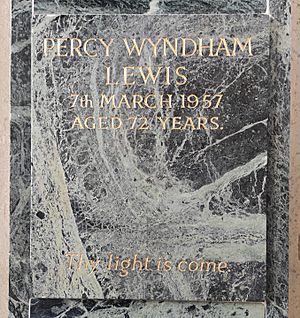Wyndham Lewis facts for kids
Quick facts for kids
Wyndham Lewis
|
|
|---|---|
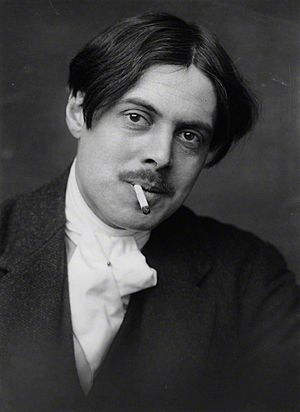
Lewis in 1913
|
|
| Born |
Percy Wyndham Lewis
18 November 1882 Amherst, Nova Scotia, Canada
|
| Died | 7 March 1957 (aged 74) London, England, United Kingdom
|
| Nationality | British |
| Education | Slade School of Fine Art, University College London |
| Known for | Painting, poetry, literature, criticism |
| Movement | Vorticism |
| Spouse(s) | Gladys Anne Hoskins (1900–1979) |
Percy Wyndham Lewis (born November 18, 1882 – died March 7, 1957) was a British writer, painter, and art critic. He helped start an art movement called Vorticism. He also edited BLAST, a magazine for Vorticist artists and writers.
His novels include Tarr (1918) and The Human Age trilogy. This trilogy has the books The Childermass (1928), Monstre Gai (1955), and Malign Fiesta (1955). He also wrote two books about his own life. These were Blasting and Bombardiering (1937) and Rude Assignment: A Narrative of my Career Up-to-Date (1950).
Contents
Wyndham Lewis: Artist and Writer
Early Life and Art Training
Lewis was born on November 18, 1882. It is said he was born on his father's yacht near Nova Scotia, Canada. His parents separated around 1893. His mother then moved back to England.
Lewis went to school in England at Rugby School. From age 16, he studied art at the Slade School of Fine Art in London. He left without finishing his course. In the early 1900s, he traveled around Europe. He spent a lot of time studying art in Paris.
Starting the Vorticism Art Movement
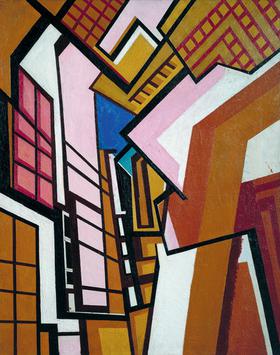
In 1908, Lewis moved to London. He lived there for most of his life. In 1909, he published his first writings. These were stories about his travels in Brittany.
In 1912, Lewis showed his art at an exhibition. He displayed drawings and oil paintings. He also created designs for an avant-garde nightclub called The Cave of the Golden Calf.
From 1913 to 1915, Lewis developed his unique art style. This style used strong geometric shapes. His friend Ezra Pound named it "Vorticism". Lewis wanted to mix the strong structure of Cubism with the energy of Futurist art. The result was a powerful and dramatic way to show modern life.
Lewis briefly worked at Roger Fry's Omega Workshops. But he left after a disagreement. He and other artists started their own workshop. It was called the Rebel Art Centre. This center led to the Vorticist group. It also created their magazine, BLAST. In BLAST, Lewis explained the Vorticist ideas. He also published a play called Enemy of the Stars.
World War I Experiences

In 1915, the Vorticists held their only exhibition in the UK. The movement soon ended because of World War I. Lewis joined the Royal Artillery as a second lieutenant. He served on the western front. He spent time in observation posts. From there, he watched German lines and directed artillery fire. He wrote vivid accounts of his dangerous experiences.
After a major battle, Lewis became an official war artist. He painted for both the Canadian and British governments. For Canada, he painted A Canadian Gun-pit (1918). For Britain, he painted A Battery Shelled (1919). This is one of his most famous works. It shows his own experiences at war. Lewis showed his war art in an exhibition called "Guns" in 1918.
Even though the Vorticist group broke up, Lewis's supporter, John Quinn, held a Vorticist exhibition in New York in 1917. Lewis's first novel, Tarr, was published in 1918. It is seen as an important modern novel.
Lewis later wrote about his war experiences in his book Blasting and Bombardiering (1937).
Art and Writing After the War
After the war, Lewis continued painting. He had a big exhibition in 1921 called Tyros and Portraits. "Tyros" were funny drawings. They made comments on the culture after World War I. A Reading of Ovid and Mr Wyndham Lewis as a Tyro are two paintings from this time. Lewis also started a new magazine called The Tyro.
By the late 1920s, he focused more on writing. He launched another magazine, The Enemy. He wrote most of it himself. The magazine showed his strong critical opinions. He believed that some art and ideas were not truly revolutionary. His main book from this time was The Art of Being Ruled (1926).
His book Time and Western Man (1927) discussed culture and philosophy. It included strong critiques of famous writers like James Joyce and Ezra Pound.
Novels and Political Views
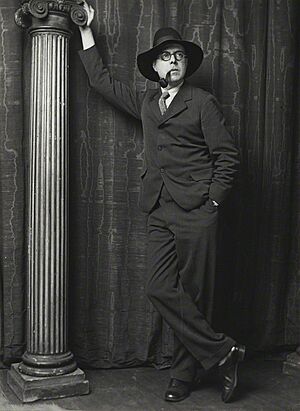
In 1930, Lewis published The Apes of God. This was a sharp, funny attack on the London literary scene. In 1937, he published The Revenge for Love. Many people think this is his best novel. It is set before the Spanish Civil War.
Despite being very ill, he wrote many critical essays and painted. He published a book of poems, One-Way Song, in 1933. He also wrote Men Without Art (1934). This book defended his satirical writing style.
Lewis's political views changed over time. In 1931, he published a book called Hitler. It presented Adolf Hitler as a "man of peace." This made him unpopular with many people. However, after visiting Germany again in 1937, Lewis changed his mind. He saw the truth about the Nazi treatment of Jewish people. In 1939, he wrote a book against anti-semitism called The Jews, Are They Human?. He also published The Hitler Cult (1939), which clearly took back his earlier support for Hitler.
Lewis believed there was a "left-wing orthodoxy" in Britain in the 1930s. He thought it was wrong for Britain to ally with the Soviet Union. He also defended liberal democracy. He believed it respected individual freedom. In America and Cosmic Man (1949), Lewis argued that Franklin Delano Roosevelt had successfully balanced individual rights with the needs of the state.
Return to Painting and Later Life

After being known more for his writing, Lewis focused on painting again in the 1930s and 1940s. Some of his best-known works are from this period. The Surrender of Barcelona (1936–37) commented on the Spanish Civil War. The Tate Gallery bought his painting Red Scene from an exhibition in 1937. This painting showed influence from Surrealism.
Lewis also painted many famous portraits. These included pictures of Edith Sitwell (1923–1936), T. S. Eliot (1938 and 1949), and Ezra Pound (1939). His 1938 portrait of Eliot was rejected by the Royal Academy. This caused a big stir.
Lewis spent World War II in the United States and Canada. He liked the diverse nature of America. He praised the contributions of African-Americans to American culture. He returned to England in 1945.
By 1951, Lewis became completely blind. This was due to a brain tumor. It ended his painting career. But he kept writing until he died. He published several autobiographical and critical books. These included Rude Assignment (1950) and Self Condemned (1954).
The BBC asked Lewis to finish his 1928 work The Childermass. It was published as The Human Age. In 1956, the Tate Gallery held a major exhibition of his work. It was called "Wyndham Lewis and Vorticism."
Personal Life
In 1930, Lewis married Gladys Anne Hoskins (1900–1979). She was 18 years younger than him. He called her Froanna. They lived together for 10 years before marrying. They never had children.
Lewis was very protective of his wife. Froanna was patient and caring. She supported him through money problems and illnesses. She was a model for some of Lewis's portraits. She also inspired characters in his books. These portraits showed her inner feelings.
Lewis was interested in Roman Catholicism but never converted. He died in 1957. He was cremated at Golders Green Crematorium. By the time he died, Lewis had written 40 books.
Legacy and Recognition
Today, people are showing more interest in Lewis's work. He is now seen as a major British artist and writer of the 20th century.
In 2007, Rugby School held an exhibition of his works. This marked 50 years since his death. The National Portrait Gallery in London had a big exhibition of his portraits in 2008. In 2010, a large exhibition of his paintings and drawings was held in Madrid, Spain.
Several of Lewis's readings are on an audiobook CD. It is called The Enemy Speaks. It was released in 2007.
A blue plaque now marks the house where Lewis lived in Kensington, London. It is at 61 Palace Gardens Terrace.
Books
- Tarr (1918) (novel)
- The Caliph's Design : Architects! Where is Your Vortex? (1919) (essay)
- The Art of Being Ruled (1926) (essays)
- The Wild Body: A Soldier of Humour And Other Stories (1927) (short stories)
- The Lion and the Fox: The Role of the Hero in the Plays of Shakespeare (1927) (essays)
- Time and Western Man (1927) (essays)
- The Childermass (1928) (novel)
- Paleface: The Philosophy of the Melting Pot (1929) (essays)
- Satire and Fiction (1930) (criticism)
- The Apes of God (1930) (novel)
- Hitler (1931) (essay)
- The Diabolical Principle and the Dithyrambic Spectator (1931) (essays)
- Doom of Youth (1932) (essays)
- Filibusters in Barbary (1932) (travel; later republished as Journey into Barbary)
- Enemy of the Stars (1932) (play)
- Snooty Baronet (1932) (novel)
- One-Way Song (1933) (poetry)
- Men Without Art (1934) (criticism)
- Left Wings over Europe; or, How to Make a War about Nothing (1936) (essays)
- Blasting and Bombardiering (1937) (autobiography)
- The Revenge for Love (1937) (novel)
- Count Your Dead: They are Alive!: Or, A New War in the Making (1937) (essays)
- The Mysterious Mr. Bull (1938)
- The Jews, Are They Human? (1939) (essay)
- The Hitler Cult and How it Will End (1939) (essay)
- America, I Presume (1940) (travel)
- Anglosaxony: A League that Works (1941) (essay)
- America and Cosmic Man (1949) (essay)
- Rude Assignment (1950) (autobiography)
- Rotting Hill (1951) (short stories)
- The Writer and the Absolute (1952) (essay)
- Self Condemned (1954) (novel)
- The Demon of Progress in the Arts (1955) (essay)
- Monstre Gai (1955) (novel)
- Malign Fiesta (1955) (novel)
- The Red Priest (1956) (novel)
- The Letters of Wyndham Lewis (1963) (letters)
- The Roaring Queen (1973; written 1936 but unpublished) (novel)
- Unlucky for Pringle (1973) (short stories)
- Mrs Duke's Million (1977; written 1908–10 but unpublished) (novel)
- Creatures of Habit and Creatures of Change (1989) (essays)
Paintings
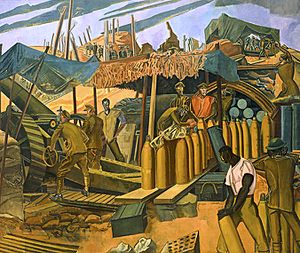

- The Theatre Manager (1909), watercolour
- Indian Dance (1912), chalk and watercolour
- Russian Madonna (also known as Russian Scene) (1912), pen and ink, watercolour
- Lovers (1912), pen and ink, watercolour
- Mother and Child (1912), oil on canvas, now lost
- The Dancers (study for Kermesse) (1912), black ink and watercolour, (image)
- Composition (1913), pen and ink, watercolour, (image)
- Plan of War (1913–14), oil on canvas
- Slow Attack (1913–14), oil on canvas
- New York (1914), pen and ink, watercolour
- Argol (1914), pen and ink, watercolour
- The Crowd (1914–15), oil paint and graphite on canvas, (image)
- Workshop (1914–15), oil on canvas, (image)
- Vorticist Composition (1915), gouache and chalk, (image)
- A Canadian Gun-pit (1919), oil on canvas, (image)
- A Battery Shelled (1919), oil on canvas, (image)
- Mr Wyndham Lewis as a Tyro (1920–21), oil on canvas, (image)
- A Reading of Ovid (Tyros) (1920–21), oil on canvas, (image)
- Seated Figure (c.1921) (image)
- Mrs Schiff (1923–24), oil on canvas, (image)
- Edith Sitwell (1923–1935), oil on canvas, (image)
- Bagdad (1927–28), oil on wood, (image}
- Three Veiled Figures (1933), oil on canvas, (image)
- Creation Myth (1933–1936, oil on canvas, (image)
- Red Scene (1933–1936), oil on canvas, (image)
- One of the Stations of the Dead (1933–1837), oil on canvas, (image}
- The Surrender of Barcelona (1934–1937), oil on canvas, (image)
- Panel for the Safe of a Great Millionaire (1936–37), oil on canvas, (image)
- Newfoundland (1936–37), oil on canvas, (image)
- Pensive Head (1937), oil on canvas, (image)
- La Suerte (1938), oil on canvas, (image)
- John Macleod (1938), oil on canvas (image)
- Ezra Pound (1939), oil on canvas, (image)
- Mrs R.J. Sainsbury (1940–41), oil on canvas, (image)
- A Canadian War Factory (1943), oil on canvas, (image)
- Nigel Tangye (1946), oil on canvas, (image)
Images for kids
See also
 In Spanish: Wyndham Lewis para niños
In Spanish: Wyndham Lewis para niños



